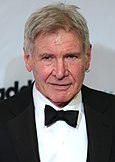Jedi, Jedi Knights, or collectively the Jedi Order are fictional characters, and often protagonists, featured in many works within the Star Wars franchise. Working symbiotically alongside the Old Galactic Republic, the Jedi Order is depicted as a religious, academic, meritocratic, and military (peacekeeping) organization whose origin dates back thousands of years before the events of the first film released in the franchise. The fictional organization has inspired a real-world new religious movement and parody religion: Jediism.

Star Wars is an American epic space opera media franchise created by George Lucas, which began with the eponymous 1977 film and quickly became a worldwide pop culture phenomenon. The franchise has been expanded into various films and other media, including television series, video games, novels, comic books, theme park attractions, and themed areas, comprising an all-encompassing fictional universe. Star Wars is one of the highest-grossing media franchises of all time.

Return of the Jedi is a 1983 American epic space opera film that is the sequel to Star Wars (1977) and The Empire Strikes Back (1980). It is the third installment in the original Star Wars trilogy and the sixth chronological film in the "Skywalker Saga". It is directed by Richard Marquand based on a screenplay by Lawrence Kasdan and George Lucas from a story by Lucas, who was also the executive producer. The film follows the ongoing struggle between the malevolent Galactic Empire and the freedom fighters of the Rebel Alliance. As the Rebels attempt to destroy the Empire's second Death Star, Luke Skywalker hopes to bring his father, Darth Vader, back from the dark side of the Force. The film stars Mark Hamill, Harrison Ford, Carrie Fisher, Billy Dee Williams, Anthony Daniels, David Prowse, Kenny Baker, Peter Mayhew and Frank Oz.
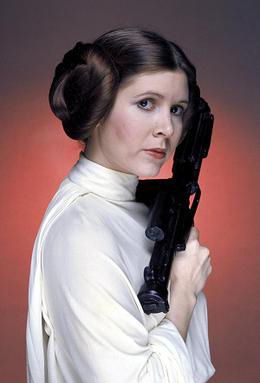
Princess Leia Organa is a fictional character and one of the main characters in the Star Wars franchise, portrayed by Carrie Fisher. Introduced in the original Star Wars film in 1977, Leia is princess of the planet Alderaan, a member of the Imperial Senate and an agent of the Rebel Alliance. She thwarts the sinister Sith Lord Darth Vader and helps bring about the destruction of the Empire's cataclysmic superweapon, the Death Star. In The Empire Strikes Back (1980), Leia commands a Rebel base and evades Vader as she falls in love with the smuggler Han Solo. In Return of the Jedi (1983), Leia helps in the operation to rescue Han from the crime lord Jabba the Hutt and is revealed to be Vader's daughter and the twin sister of Luke Skywalker.

Luke Skywalker is a fictional character and the protagonist of the original film trilogy of the Star Wars franchise created by George Lucas. Portrayed by Mark Hamill, Luke first appeared in Star Wars (1977), and he returned in The Empire Strikes Back (1980) and Return of the Jedi (1983). Over three decades later, Hamill returned as Luke in the Star Wars sequel trilogy, with a cameo in The Force Awakens (2015) before playing a major role in The Last Jedi (2017) and The Rise of Skywalker (2019). He later played a digitally de-aged version of the character in the Disney+ series The Mandalorian, appearing in the second-season finale, which premiered in 2020, and The Book of Boba Fett, in the sixth episode, released in 2022.
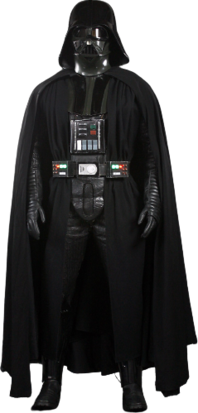
Darth Vader is a character in the Star Wars franchise. He is the primary antagonist of the original film trilogy and, as Anakin Skywalker, is the protagonist of the prequel trilogy. Born a slave on the planet Tatooine, he becomes a powerful Jedi. He is lured to the dark side of the Force by Chancellor Palpatine, and becomes the Sith Lord Darth Vader. After being severely wounded in a lightsaber battle, he is transformed into a cyborg. He is the husband of Padmé Amidala and the biological father of Luke Skywalker and Leia Organa Solo.

The Empire Strikes Back is a 1980 American epic space opera film directed by Irvin Kershner from a screenplay by Leigh Brackett and Lawrence Kasdan, based on a story by George Lucas. The sequel to Star Wars (1977), it is the second film in the Star Wars film series and the fifth chronological chapter of the "Skywalker Saga". Set three years after the events of Star Wars, the film recounts the battle between the malevolent Galactic Empire, led by the Emperor, and the Rebel Alliance, led by Princess Leia. Rebel ally Luke Skywalker trains to master the Force so he can confront the Emperor's powerful disciple, Darth Vader. The ensemble cast includes Mark Hamill, Harrison Ford, Carrie Fisher, Billy Dee Williams, Anthony Daniels, David Prowse, Kenny Baker, Peter Mayhew, and Frank Oz.
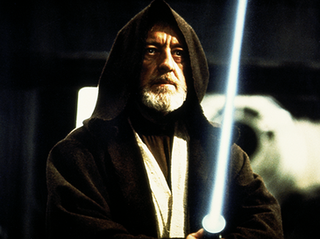
Obi-Wan Kenobi is a fictional character in the Star Wars franchise. Within the original trilogy, Obi-Wan is a Jedi Master as a supporting character and is portrayed by English actor Alec Guinness. In the later-released prequel trilogy, a younger version of the character serves as one of the two main protagonists, alongside Anakin Skywalker, and is portrayed by Scottish actor Ewan McGregor. In the original trilogy he is introduced as Ben Kenobi, an alias he uses while in hiding from the Empire. He is a mentor to Luke Skywalker, to whom he introduces the ways of the Jedi. After sacrificing himself in a duel against Darth Vader, Obi-Wan guides Luke through the Force in his fight against the Galactic Empire. In the prequel trilogy, set two decades earlier, he is initially a Padawan (apprentice) to Jedi Master Qui-Gon Jinn, and later mentor and friend of Luke's father Anakin, who falls to the dark side of the Force and becomes Vader. The character briefly appears in the sequel trilogy as a disembodied voice, speaking to protagonist Rey, and serving as the namesake of Ben Solo. He is frequently featured as a main character in various other Star Wars media, including the streaming television miniseries Obi-Wan Kenobi, in which McGregor reprised the role.
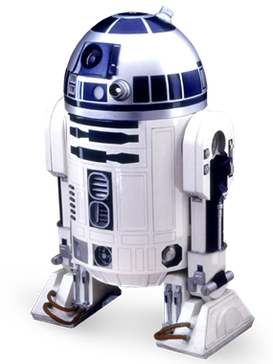
R2-D2 or Artoo-Detoo is a fictional robot character in the Star Wars franchise created by George Lucas. He has appeared in ten of the eleven theatrical Star Wars films to date, including every movie in the original trilogy, prequel trilogy, and sequel trilogy. At various points throughout the course of the films, R2, an astromech droid, is a friend to C-3PO, Padmé Amidala, Anakin Skywalker, Leia Organa, Luke Skywalker, and Obi-Wan Kenobi. R2-D2 and his companion C-3PO are the only characters to appear in every theatrical Star Wars film, with the exception of Solo: A Star Wars Story (2018).

C-3PO or See-Threepio is a humanoid robot character in the Star Wars franchise who appears in every movie of the original trilogy, the prequel trilogy and the sequel trilogy. Built by Anakin Skywalker, C-3PO was designed as a protocol droid intended to assist in etiquette, customs, and translation, boasting that he is "fluent in over six million forms of communication". Along with his astromech droid counterpart and friend R2-D2, C-3PO provides comic relief within the narrative structure of the films, and serves as a foil. Anthony Daniels has portrayed the character in eleven of the twelve theatrical Star Wars films released to date, with the exception of Solo: A Star Wars Story, where the character does not appear.

A radio dramatization of the original Star Wars film trilogy was produced in 1981, 1983, and 1996. The first two radio series, based on Star Wars and The Empire Strikes Back, were produced and broadcast by National Public Radio (NPR) as part of NPR Playhouse. A dramatization of Return of the Jedi was produced by most of the same team and it was also broadcast on NPR.

The Skywalker family is a fictional legendary human family in the Star Wars franchise. Within the series' fictional universe, the Skywalkers are presented as a bloodline with strong inherent capabilities related to the Force and sometimes lightsaber skills. Luke Skywalker, his twin sister Princess Leia Organa, and their father Darth Vader are central characters in the original Star Wars film trilogy. Darth Vader, in his previous identity as Anakin Skywalker, is a lead character in the prequel film trilogy and so is his wife and the twins' mother Padmé Amidala; while his mother Shmi is a minor character in the first and second films respectively. Leia and Han Solo's son, Ben Solo, renamed himself Kylo Ren and is the main antagonist in the sequel film trilogy, while they and Luke serve as supporting characters. Shmi, Padmé, and Han are the only members who are not Force-sensitive. The Skywalker bloodline, alongside the Palpatine bloodline, are the two bloodlines that are the strongest with the Force.
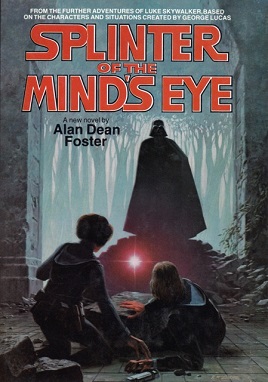
Splinter of the Mind's Eye is a 1978 science fiction novel by American writer Alan Dean Foster, a sequel to the film Star Wars (1977). Originally published in 1978 by Del Rey, a division of Ballantine Books, the book was written with the intention of being adapted as a low-budget sequel to Star Wars in case the original film was not successful enough to finance a high-budget sequel.
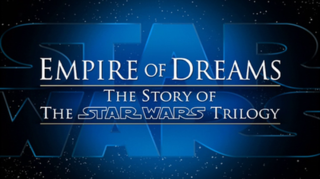
Empire of Dreams: The Story of the Star Wars Trilogy is a 2004 documentary film directed by Kevin Burns and narrated by Robert Clotworthy. It documents the making of the original Star Wars trilogy: Star Wars (1977), The Empire Strikes Back (1980), and Return of the Jedi (1983), and their impact on popular culture.
The Star Wars prequel trilogy, colloquially referred to as the prequels, is a series of epic space-opera films written and directed by George Lucas. It was produced by Lucasfilm Ltd. and distributed by 20th Century Fox. The trilogy was released from 1999 to 2005 and is set before the original Star Wars trilogy (1977–1983), chronologically making it the first act of the Skywalker Saga. Lucas had planned a prequel trilogy before the release of the original film, but halted major Star Wars films beyond the original trilogy by 1981. When computer-generated imagery (CGI) had advanced to the level he wanted for the visual effects he wanted for subsequent films, Lucas revived plans for the prequels by the early 1990s. The trilogy marked Lucas's return to directing after a 22-year hiatus following the original Star Wars film in 1977, as well as a 16-year hiatus between the classic and prequel trilogies.
The Star Wars sequel trilogy is the third trilogy of the main Star Wars franchise, an American space opera created by George Lucas. It is produced by Lucasfilm Ltd. and distributed by Walt Disney Studios Motion Pictures. The trilogy consists of episodes, chronologically following the prequel trilogy and the original trilogy, serving as the final act of the "Skywalker Saga". Lucas had planned a sequel trilogy as early as 1976, but canceled it by 1981. He produced only the first six episodes, and for a time described these as comprising the complete story. The sequel trilogy concept was revived when the Walt Disney Company entered negotiations to acquire Lucasfilm in 2011. Lucas produced new story treatments, but these were largely discarded. Both the acquisition and plans to produce the trilogy were announced in late 2012.
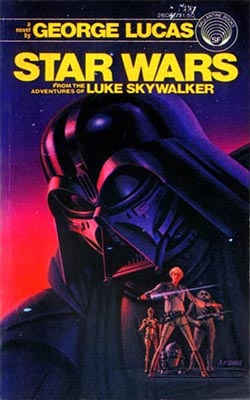
Star Wars: From the Adventures of Luke Skywalker is the novelization of the 1977 film Star Wars, ghostwritten by Alan Dean Foster, but credited to George Lucas. It was first published on November 12, 1976, by Ballantine Books, several months before the release of the film. In later years, it was republished under the title Star Wars: A New Hope to reflect the retroactive addition of a subtitle to the film in 1981.

Sheev Palpatine is a fictional character in the Star Wars franchise created by George Lucas. He first appears on screen in The Empire Strikes Back (1980), in which he is credited as The Emperor, and is the overarching antagonist of the three film trilogies in the Skywalker Saga, in which he is portrayed by Ian McDiarmid. The character is also known by his Sith name, Darth Sidious, which was first used in the novelization of The Phantom Menace (1999). In creating Palpatine, Lucas was inspired by real-world examples of democratic backsliding during the rise and rule of dictators such as Julius Caesar, Napoleon Bonaparte, and Adolf Hitler.

Han Solo is a fictional character in the Star Wars franchise created by George Lucas. The character first appeared in the 1977 film Star Wars portrayed by Harrison Ford, who reprised his role in The Holiday Special (1978), The Empire Strikes Back (1980), and Return of the Jedi (1983). Ford returned to the role for The Force Awakens (2015), as well as a brief cameo in The Rise of Skywalker (2019). In the spin-off film Solo (2018), a younger version of the character is portrayed by Alden Ehrenreich, while in the animated series Forces of Destiny (2017–2018), the character is voiced by Kiff VandenHeuvel and A.J. LoCascio.

"Robot Chicken: Star Wars Episode II" is a 2008 episode of the television comedy series Robot Chicken, and the sequel to the Annie Award winning "Robot Chicken: Star Wars", which aired as a one-off special during Cartoon Network's Adult Swim block on November 16, 2008. Like "Robot Chicken: Star Wars", it has been released on its own DVD on July 21, 2009, and will not be part of a season box set. The DVD contains the original broadcast version, and the "Extended Version", which features an additional 15 minutes of footage cut from the broadcast version. It was nominated for a 2009 Primetime Emmy Award for Outstanding Animated Program.



